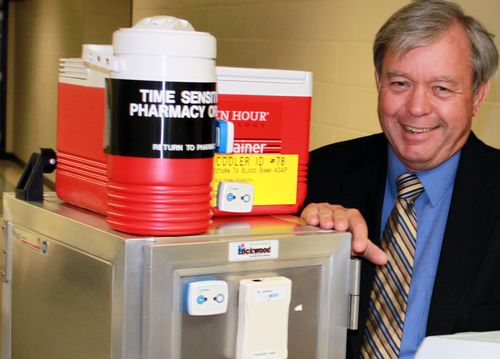A blood-bank management system using RFID technology is working so well at Wake Forest Baptist Medical Center (WFBMC) that the hospital has applied for a patent and helped found a company to sell the system to other hospitals. The solution, dubbed Time Temp Trac, consists of an add-on to Wake Forest’s existing real-time location system (RTLS) software to allow staff to track how long a blood cooler is outside the blood bank. By using the system for its 35 coolers, the hospital has been able to ensure the coolers don’t get lost, and staff members receive updates when the products are scheduled to be returned to the blood bank to ensure they meet Food and Drug Administration (FDA) temperature requirements for storage.
Prior to using the new system, which was installed in August of last year, staff often didn’t know just where its coolers were in the facility. To comply with FDA regulations regarding storage temperature of blood, the hospital purchased higher-quality Minnesota Thermal Science coolers that can keep the blood at an acceptable temperature. However, because the coolers are expensive, says Mary Rose Jones, blood bank/bone marrow transplant processing manager, she was interested in tracking their location to ensure they returned to the blood bank.

WFBMC, located in Winston-Salem, N.C., first began testing various RTLS systems to track assets in 2005. Ultimately, in 2009, it selected a system consisting of hardware from CenTrak and software from Patient Care Technology Systems (PCTS)—now owned by Awarepoint—to track the location of items such as IV poles and pumps as they move around the four-million-square-foot campus (see Wake Forest Med Center Launches Vaccine-Tracking RTLS). In August 2010, the hospital began tracking its coolers, affixing each one with a CenTrak RFID tag encoded with a unique ID number linked to the cooler in the RTLS system. As the coolers move around the facility, their locations are tracked, using the existing RFID readers and infrared emitters in the hospital.In addition, Ronald Noel, WFBMC’s receiving manager and the developer of Time Temp Trac, wrote the specifications for the system and PCTS programmed the software so that blood bank staff could identify when a cooler leaves the blood bank area (presumably filled with blood bags) and begin a timer that is set for 10 hours—the time determined to maintain a temperature of 1 degree to six degrees Celsius. The status of each cooler is represented with color-coded icons on one of two computer screens, installed at the blood bank front desk. Green indicates the cooler is available for use at the blood bank, blue means the cooler has left the blood bank and is in use (this is when the timer starts). The status icon changes to yellow when the timer reaches 15 minutes before the 10-hour limit, turns orange when the limit has been reached, and red, 15 minutes after that.
In addition, the software is programmed to send reminders to staff via an e-mail to the front desk, where the second computer monitor displays the e-mailed reminders. The first e-mail arrives 15 minutes before expiration of the validated time limit, then a second e-mail arrives at the time of expiration and a final e-mail arrives 15 minutes after the validation time limit. With each message, the cooler that needs to be retrieved is listed, as well as its location as determined by the RTLS system. Staff seated at the front desk see these updates and can begin arranging for the cooler’s return by making a phone call.
Although the system was developed using the hospital’s existing PCTS system, the hospital is working with Wi-Fi based RTLS technology provider Ekahau to further develop the system so that staff members, wearing Ekahau badges, can receive alerts on their badges, enabling them to respond to a cooler retrieval request from wherever they are located on the hospital campus. That system may be available for Ekahau’s RTLS system installations this fall, Noel says.
Since the Time Temp Trac system was established, Jones says, there have been no more misplaced coolers. “Since the system started in August, we haven’t lost a single cooler, which is remarkable,” she says. “We feel we’ve made a good move” by implementing the new system. While previously blood bank staff had to make multiple phone calls to departments such as the operating rooms (OR) in an effort to locate the coolers, now the location is identified automatically. The hospital has yet not analyzed the amount of wastage of blood in coolers before and after the system was installed, Jones says.
Noel says Time Temp Trac will be commercially available within the next few months. Hospitals will then be able to purchase, from Time Temp Trac, the license for intellectual property, while those users’ RTLS vendors can provide any necessary modifications to the system in their software. Ekahau’s newest software offering, Vision 2, is designed to accommodate the blood cooler tracking system, Noel says, but other RTLS providers could do so as well. The Time Temp Trac system could also be used to track other time- or temperature-sensitive products such as pharmaceuticals or food, he adds.

